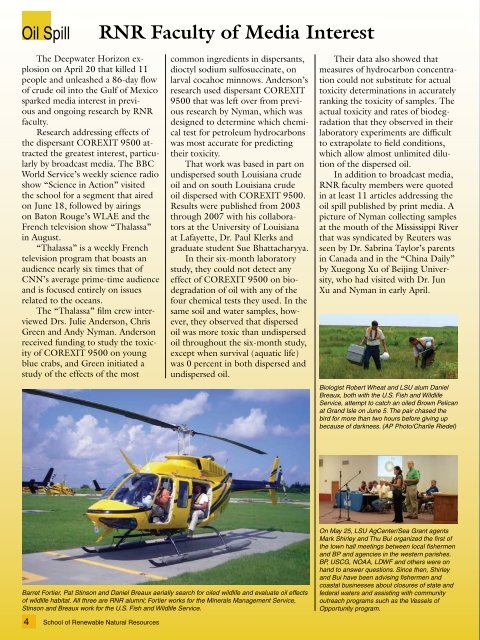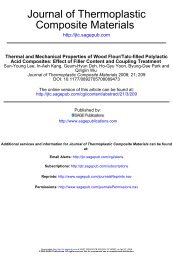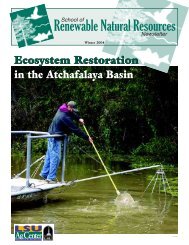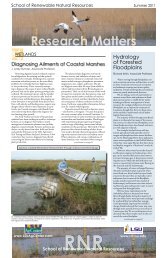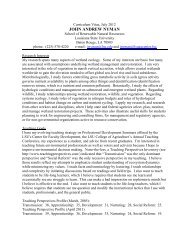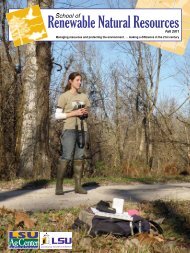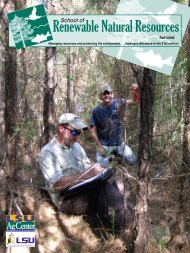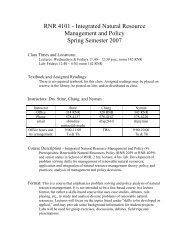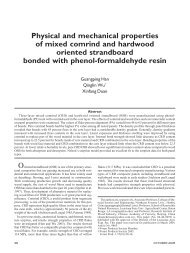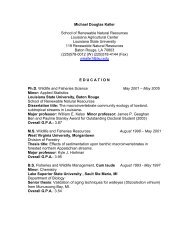Fall 2010 - LSU School of Renewable Natural Resources ...
Fall 2010 - LSU School of Renewable Natural Resources ...
Fall 2010 - LSU School of Renewable Natural Resources ...
Create successful ePaper yourself
Turn your PDF publications into a flip-book with our unique Google optimized e-Paper software.
Oil Spill<br />
RNR Faculty <strong>of</strong> Media Interest<br />
The Deepwater Horizon explosion<br />
on April 20 that killed 11<br />
people and unleashed a 86-day flow<br />
<strong>of</strong> crude oil into the Gulf <strong>of</strong> Mexico<br />
sparked media interest in previous<br />
and ongoing research by RNR<br />
faculty.<br />
Research addressing effects <strong>of</strong><br />
the dispersant COREXIT 9500 attracted<br />
the greatest interest, particularly<br />
by broadcast media. The BBC<br />
World Service’s weekly science radio<br />
show “Science in Action” visited<br />
the school for a segment that aired<br />
on June 18, followed by airings<br />
on Baton Rouge’s WLAE and the<br />
French television show “Thalassa”<br />
in August.<br />
“Thalassa” is a weekly French<br />
television program that boasts an<br />
audience nearly six times that <strong>of</strong><br />
CNN’s average prime-time audience<br />
and is focused entirely on issues<br />
related to the oceans.<br />
The “Thalassa” film crew interviewed<br />
Drs. Julie Anderson, Chris<br />
Green and Andy Nyman. Anderson<br />
received funding to study the toxicity<br />
<strong>of</strong> COREXIT 9500 on young<br />
blue crabs, and Green initiated a<br />
study <strong>of</strong> the effects <strong>of</strong> the most<br />
common ingredients in dispersants,<br />
dioctyl sodium sulfosuccinate, on<br />
larval cocahoe minnows. Anderson’s<br />
research used dispersant COREXIT<br />
9500 that was left over from previous<br />
research by Nyman, which was<br />
designed to determine which chemical<br />
test for petroleum hydrocarbons<br />
was most accurate for predicting<br />
their toxicity.<br />
That work was based in part on<br />
undispersed south Louisiana crude<br />
oil and on south Louisiana crude<br />
oil dispersed with COREXIT 9500.<br />
Results were published from 2003<br />
through 2007 with his collaborators<br />
at the University <strong>of</strong> Louisiana<br />
at Lafayette, Dr. Paul Klerks and<br />
graduate student Sue Bhattacharyya.<br />
In their six-month laboratory<br />
study, they could not detect any<br />
effect <strong>of</strong> COREXIT 9500 on biodegradation<br />
<strong>of</strong> oil with any <strong>of</strong> the<br />
four chemical tests they used. In the<br />
same soil and water samples, however,<br />
they observed that dispersed<br />
oil was more toxic than undispersed<br />
oil throughout the six-month study,<br />
except when survival (aquatic life)<br />
was 0 percent in both dispersed and<br />
undispersed oil.<br />
Their data also showed that<br />
measures <strong>of</strong> hydrocarbon concentration<br />
could not substitute for actual<br />
toxicity determinations in accurately<br />
ranking the toxicity <strong>of</strong> samples. The<br />
actual toxicity and rates <strong>of</strong> biodegradation<br />
that they observed in their<br />
laboratory experiments are difficult<br />
to extrapolate to field conditions,<br />
which allow almost unlimited dilution<br />
<strong>of</strong> the dispersed oil.<br />
In addition to broadcast media,<br />
RNR faculty members were quoted<br />
in at least 11 articles addressing the<br />
oil spill published by print media. A<br />
picture <strong>of</strong> Nyman collecting samples<br />
at the mouth <strong>of</strong> the Mississippi River<br />
that was syndicated by Reuters was<br />
seen by Dr. Sabrina Taylor’s parents<br />
in Canada and in the “China Daily”<br />
by Xuegong Xu <strong>of</strong> Beijing University,<br />
who had visited with Dr. Jun<br />
Xu and Nyman in early April.<br />
Biologist Robert Wheat and <strong>LSU</strong> alum Daniel<br />
Breaux, both with the U.S. Fish and Wildlife<br />
Service, attempt to catch an oiled Brown Pelican<br />
at Grand Isle on June 5. The pair chased the<br />
bird for more than two hours before giving up<br />
because <strong>of</strong> darkness. (AP Photo/Charlie Riedel)<br />
Barret Fortier, Pat Stinson and Daniel Breaux aerially search for oiled wildlife and evaluate oil effects<br />
<strong>of</strong> wildlife habitat. All three are RNR alumni; Fortier works for the Minerals Management Service,<br />
Stinson and Breaux work for the U.S. Fish and Wildlife Service.<br />
On May 25, <strong>LSU</strong> AgCenter/Sea Grant agents<br />
Mark Shirley and Thu Bui organized the first <strong>of</strong><br />
the town hall meetings between local fishermen<br />
and BP and agencies in the western parishes.<br />
BP, USCG, NOAA, LDWF and others were on<br />
hand to answer questions. Since then, Shirley<br />
and Bui have been advising fishermen and<br />
coastal businesses about closures <strong>of</strong> state and<br />
federal waters and assisting with community<br />
outreach programs such as the Vessels <strong>of</strong><br />
Opportunity program.<br />
4 <strong>School</strong> <strong>of</strong> <strong>Renewable</strong> <strong>Natural</strong> <strong>Resources</strong>


